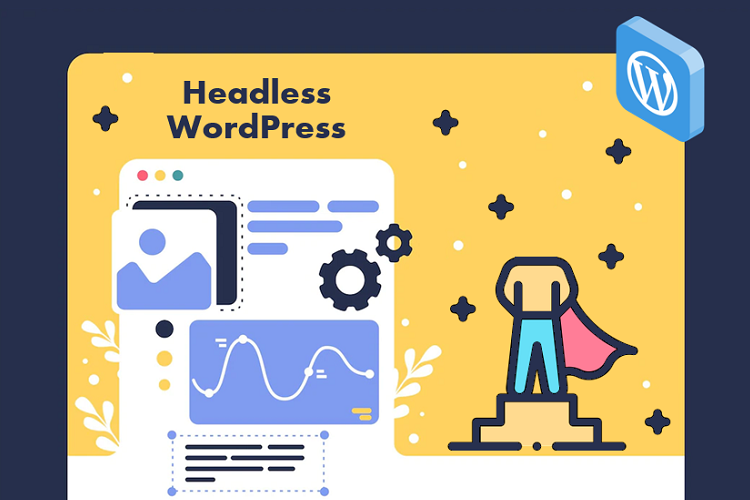WordPress is a robust content management system. Thanks to its interconnected system of themes, plugins, and other resources, you can build your site easily. You can style it with no limits and code.
One simple way to make it more effective is by going headless. The approach offers you more resilience on the back-end and access to the front-end tools. You can also use the same content bucket for different outputs.
Need a complete guide on it? Here it is. But first, do you have in-depth insights about What WordPress is? No, read out the section below.
A brief intro to WordPress
WordPress is the most prominent Content Management System all over the globe. As per the W3Techs, it powers 43.3% of websites in the world.
Introduced in 2003, WordPress has become a tech juggernaut. It aids businesses and people all over the world to build their digital existence.
Regardless, WordPress has a tightly coupled backend and frontend. This makes it tough for developers to create a digital experience.
You can go with Headless WordPress. It unlocks various new opportunities that include delivery channels, new frameworks, etc.
In a traditional way, WordPress is built as one monolithic platform. It lets you manage, store, and present content. But there are some drawbacks of Monolithic WordPress. Let’s read about it.
The Drawbacks of Monolithic WordPress
Themes are basically an assortment of template files. Most WordPress sites install and use them to display content.
A WordPress theme combines PHP template tags and HTML. It further controls the particular page layout for the individual blog posts. The drawback of this template-based system is that you can access content only as HTML. You will have to use the document structure given by each template for this.
Traditional WordPress also gives content to the website user through server-side rending. When a user visits a new web page, the browser reaches out to the web server and gets all the required content. This slow downs the process and ultimately ruins the website experience.
Besides this, the WordPress REST API returns JSON in spite of HTML. If you use a content API, it will give you enough resilience for using different types of the frontend. For instance, you can use a native mobile application, vanilla JavaScript, and more.
The best solution for all of this is to use a Headless CMS. How? Read further.
How Headless Content Management System can help you?
A CMS that is uncoupled to any frontend is called Headless CMS. You can access its content through an API that connects your frontend (head) to a backend.
A headless CMS removes the limitation for presenting content. It allows you to use one source of content and deliver it to mobile apps, websites, etc.
In contrast to traditional platforms like WordPress, a headless CMS creates & stores XML files or JSON. These files are read and presented by a frontend framework like Next.js or Gatsby. This enables you to build, test, and effectively use digital experience freely.
Most people will tell you to leave WordPress completely if you choose Headless WordPress. It is because you can have headless architecture benefits by decoupling the platform. How you will decouple the platform? We will know it further.
But first, let’s know all about Headless WordPress.
What is Headless WordPress?
A site server runs code when you load a Website page on a WordPress. It builds an HTML document that is sent to your browser. For this reason, web apps and WordPress are called server-side apps.
Headless WordPress is a different method to build web applications. It is also known as client-side development or decoupled WordPress. A server is not used to create and manage the app’s interface. It is usually done on a browser.
A website has many benefits when it is built with headless WordPress. One of the primary benefits is decoupling your developers and content editing teams.
Your content and marketing teams can use their WordPress interface with Headless WordPress. Your development team can also use appropriate tools such as Git workflow, GraphQL, etc.
Benefits of headless WordPress
A headless WordPress may work better than a typical WordPress for a business site. Here are some key reasons:
Improve security
Static-Site Generators work as a frontend for WordPress sites. It has no reachable and active web servers. Thus, presents a surface for smaller attacks. This approach prevents accidental exposure, malicious request, etc.
Enhances performance
Traditional WordPress renders web pages in a dynamic way. This means whenever a request comes in, the hosting server forms an HTML page. It does not store static HTML pages.
Building an HTML page requires a server to run PHP and MySQL processes. This will take out all the essential resources from the database. It will gather them into a page and send the page to a user.
The applications like next.js or npm almost require no scripting when a user visits your site. You can enhance site loading speed by leaving the front-end delivery to a distinct application. As per Popov, you almost don’t require scripting with these applications when a visitor visits your site. It is because they search content from the database and gather it into a pre-rendered HTML page. After that, it is shipped to the requested clients.
You can do simple things to enhance performance in a standard WordPress. But if you have a business site with lots of traffic, Headless WordPress is best.
Publishing on multichannel
You might use WordPress for your standard mobile and desktop websites. However, if you have a scaling business, you may want your content to be on additional interfaces. In such a case, you can work with Headless WordPress. It can work as a single source for multiple publishing channels.
Popov in his WCEU session explains that one WordPress installation feeds numerous headless channels. He said,” Website admin can add content at the back end so that it can be used by any app or site (that read data).”
If you change some content in the CMS it will be automatically visible on every connected device.
When to use Headless WordPress
Anybody can go for headless WordPress. It offers performance benefits which makes it a better option for you to take WordPress to next level.
You should use Headless WordPress when you want:
To build a custom product
You should go for headless WordPress if customizability is a must for you. The headless architecture offers you accessibility to other workflows and processes. Its solution enables you to have complete control over your site.
To prepare for publishing content on multiple platforms
You can create a personalized and cross-channel content strategy with decoupled WordPress. This will push your content to different channels and increase reach & traffic.
How can you set up a headless WordPress site?
There are diverse ways to start using headless WordPress. Your method may vary on the basis of your frameworks, languages, resources, etc. However, you should be familiar with the WordPress REST API and front-end languages.
We have divided the different methods for headless WordPress into two common categories. These are “Coding it yourself” and “Plugins”. Here is a brief explanation about them.
Coding it by yourself
Plugins make API implementation more effortless. But you cannot deny the fact that the DIY coding method is best if you want resilience. There are numerous tutorials available online. These tutorials explain step-by-step and in-depth “How you can implement and configure the headless method in your WordPress copy?”
We recommend you learn a front-end framework rather than building the site front-end from scratch. One of the frameworks is Gatsby. It is well-known for its adaptability with WordPress. You can handle your content with it via WordPress.
Plugins
WordPress plugins usually serve as a workaround to write code. Unfortunately, this is not the case with headless WordPress plugins. It still requires you to have knowledge about API concepts and relevant programming languages. This will support you to build the front end.
There are eminent and free plugins which you can access easily. We recommend you WPGraphQL plugin. It will allow you to convert WordPress installation into an API of GraphQL. This means you can create your own data schemas. These data schemes can be used by any front-end client to recover data from headless CMS.
You can consider the CoCart WordPress plugin if you are interested in headless e-commerce. The plugin puts a headless API on top of your WooCommerce store. This enables front-end clients to create an order for store resources.
Conclusions
We know it very well that headless WordPress cannot be a substitute for traditional WordPress. Rather it is a viable option for big businesses to support the maintenance and application costs. You might have to work more to start it, but this approach can save a lot of time.
Also, you can have more flexibility on the front-end than WordPress with the headless approach.
Jinny Sarah Jacob is a Sr. Technical content writer at 24×7 WP Support, a leading WordPress development company that supports WordPress themes, plugins, and errors. She is a passionate technology geek at heart, and loves to write blogs on marketing, technology, B2B, big data/analytics, business strategizing, etc.




